Презентация foreign exchange




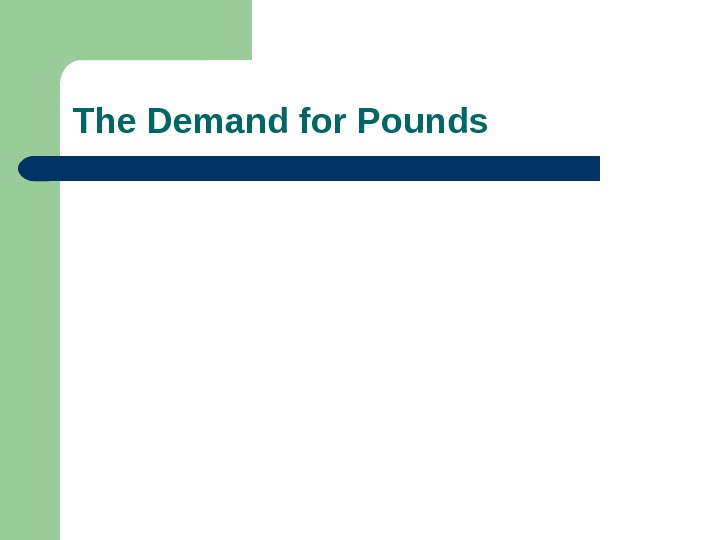
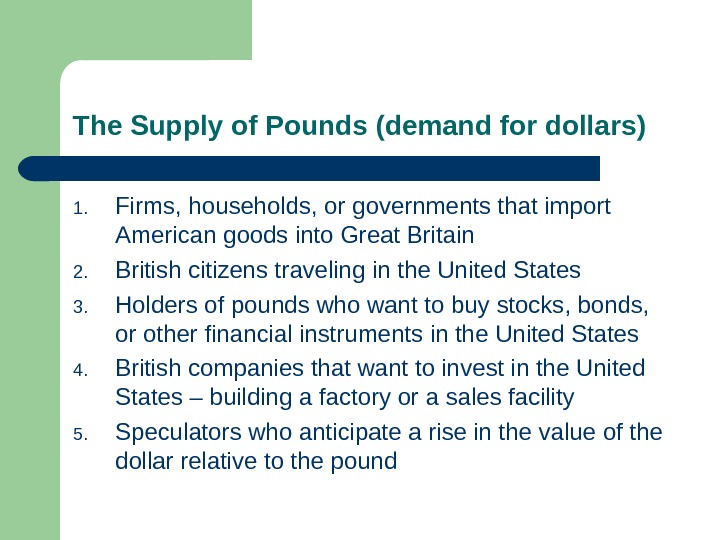
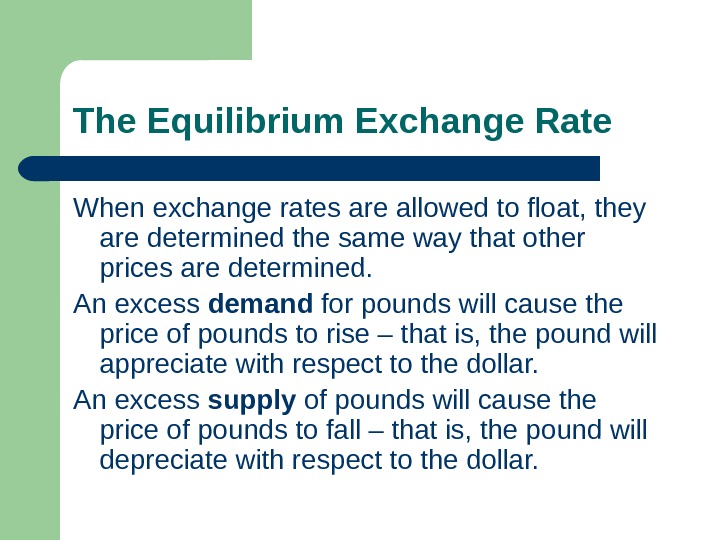
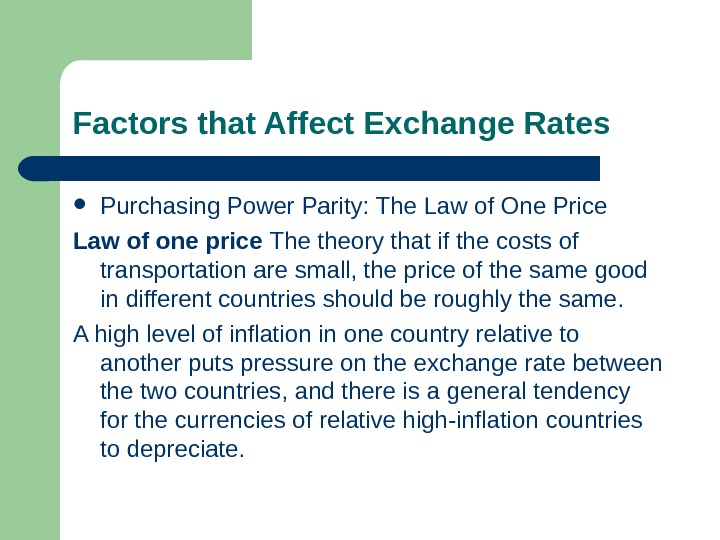

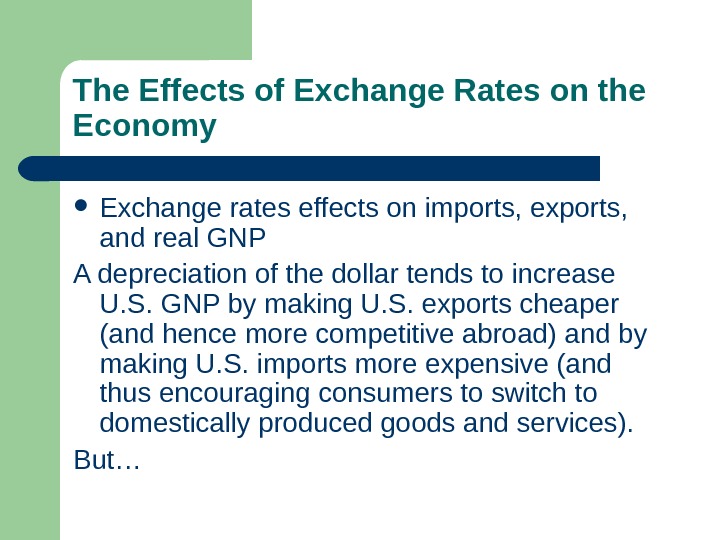
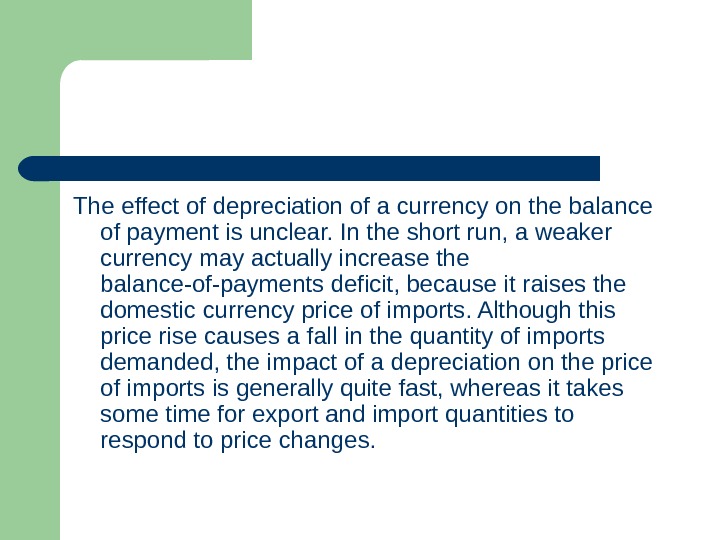


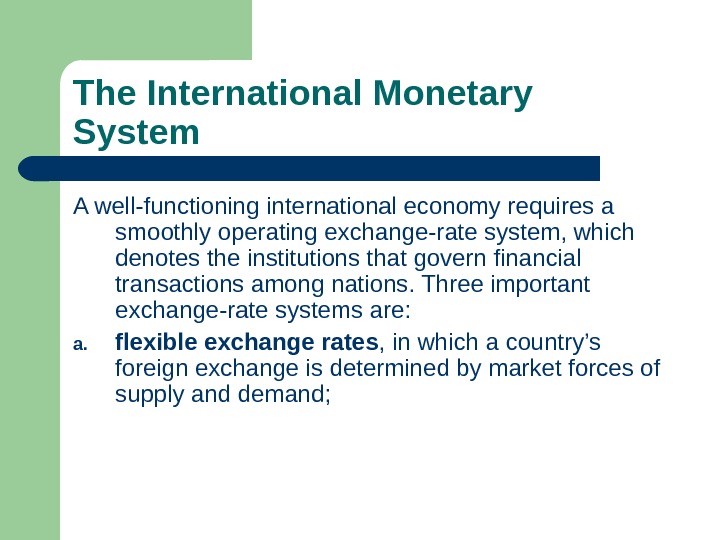

- Размер: 88 Кб
- Количество слайдов: 15
Описание презентации Презентация foreign exchange по слайдам
 Part III. International Economics Understanding Foreign Exchange
Part III. International Economics Understanding Foreign Exchange
 What is foreign exchange? Foreign exchange is the act of trading different nations’ money. An exchange rate is the price of one nation’s money in terms of another nation’s money. There actually two basic types of exchange rate, depending on the timing of actual exchange of the moneys. The spot exchange rate is the price for “immediate” exchange. The forward exchange rate is the price for an exchange that will take place sometime in the future.
What is foreign exchange? Foreign exchange is the act of trading different nations’ money. An exchange rate is the price of one nation’s money in terms of another nation’s money. There actually two basic types of exchange rate, depending on the timing of actual exchange of the moneys. The spot exchange rate is the price for “immediate” exchange. The forward exchange rate is the price for an exchange that will take place sometime in the future.
 The Market for Foreign Exchange Assume that there are just two countries, the United States and Great Britain. In this two-country case, those who demand pounds are holders of dollars who are seeking to exchange them for pounds. Those who supply pounds are holders of pounds who are seeking to exchange them for dollars. The demand for, and supply of, pounds on foreign exchange market determines the exchange rate.
The Market for Foreign Exchange Assume that there are just two countries, the United States and Great Britain. In this two-country case, those who demand pounds are holders of dollars who are seeking to exchange them for pounds. Those who supply pounds are holders of pounds who are seeking to exchange them for dollars. The demand for, and supply of, pounds on foreign exchange market determines the exchange rate.
 The Demand for Pounds (supply of dollars) 1. Firms, householders, or governments that import British goods into United States 2. U. S. citizens traveling in Great Britain 3. Holders of dollars who want to buy British stocks, bonds, or other financial instruments 4. U. S. companies that want to invest in Great Britain – building a factory or a sales facility 5. Speculators who anticipate a decline in the value of the dollar relative to the pound
The Demand for Pounds (supply of dollars) 1. Firms, householders, or governments that import British goods into United States 2. U. S. citizens traveling in Great Britain 3. Holders of dollars who want to buy British stocks, bonds, or other financial instruments 4. U. S. companies that want to invest in Great Britain – building a factory or a sales facility 5. Speculators who anticipate a decline in the value of the dollar relative to the pound
 The Demand for Pounds
The Demand for Pounds
 The Supply of Pounds (demand for dollars) 1. Firms, households, or governments that import American goods into Great Britain 2. British citizens traveling in the United States 3. Holders of pounds who want to buy stocks, bonds, or other financial instruments in the United States 4. British companies that want to invest in the United States – building a factory or a sales facility 5. Speculators who anticipate a rise in the value of the dollar relative to the pound
The Supply of Pounds (demand for dollars) 1. Firms, households, or governments that import American goods into Great Britain 2. British citizens traveling in the United States 3. Holders of pounds who want to buy stocks, bonds, or other financial instruments in the United States 4. British companies that want to invest in the United States – building a factory or a sales facility 5. Speculators who anticipate a rise in the value of the dollar relative to the pound
 The Equilibrium Exchange Rate When exchange rates are allowed to float, they are determined the same way that other prices are determined. An excess demand for pounds will cause the price of pounds to rise – that is, the pound will appreciate with respect to the dollar. An excess supply of pounds will cause the price of pounds to fall – that is, the pound will depreciate with respect to the dollar.
The Equilibrium Exchange Rate When exchange rates are allowed to float, they are determined the same way that other prices are determined. An excess demand for pounds will cause the price of pounds to rise – that is, the pound will appreciate with respect to the dollar. An excess supply of pounds will cause the price of pounds to fall – that is, the pound will depreciate with respect to the dollar.
 Factors that Affect Exchange Rates Purchasing Power Parity: The Law of One Price Law of one price The theory that if the costs of transportation are small, the price of the same good in different countries should be roughly the same. A high level of inflation in one country relative to another puts pressure on the exchange rate between the two countries, and there is a general tendency for the currencies of relative high-inflation countries to depreciate.
Factors that Affect Exchange Rates Purchasing Power Parity: The Law of One Price Law of one price The theory that if the costs of transportation are small, the price of the same good in different countries should be roughly the same. A high level of inflation in one country relative to another puts pressure on the exchange rate between the two countries, and there is a general tendency for the currencies of relative high-inflation countries to depreciate.
 … Relative interest rates and exchange rates An increase in a country’s interest rate relative to other countries’ interest rates tends to appreciate its currency.
… Relative interest rates and exchange rates An increase in a country’s interest rate relative to other countries’ interest rates tends to appreciate its currency.
 The Effects of Exchange Rates on the Economy Exchange rates effects on imports, exports, and real GNP A depreciation of the dollar tends to increase U. S. GNP by making U. S. exports cheaper (and hence more competitive abroad) and by making U. S. imports more expensive (and thus encouraging consumers to switch to domestically produced goods and services). But…
The Effects of Exchange Rates on the Economy Exchange rates effects on imports, exports, and real GNP A depreciation of the dollar tends to increase U. S. GNP by making U. S. exports cheaper (and hence more competitive abroad) and by making U. S. imports more expensive (and thus encouraging consumers to switch to domestically produced goods and services). But…
 The effect of depreciation of a currency on the balance of payment is unclear. In the short run, a weaker currency may actually increase the balance-of-payments deficit, because it raises the domestic currency price of imports. Although this price rise causes a fall in the quantity of imports demanded, the impact of a depreciation on the price of imports is generally quite fast, whereas it takes some time for export and import quantities to respond to price changes.
The effect of depreciation of a currency on the balance of payment is unclear. In the short run, a weaker currency may actually increase the balance-of-payments deficit, because it raises the domestic currency price of imports. Although this price rise causes a fall in the quantity of imports demanded, the impact of a depreciation on the price of imports is generally quite fast, whereas it takes some time for export and import quantities to respond to price changes.
 The initial effect is thus likely to be negative, and after exports and imports have had time to respond, the net effect turns positive. The tendency for the balance-of-payments deficit to widen and then to decrease as the result of a depreciation of the exchange rate is known as the J-curve effect.
The initial effect is thus likely to be negative, and after exports and imports have had time to respond, the net effect turns positive. The tendency for the balance-of-payments deficit to widen and then to decrease as the result of a depreciation of the exchange rate is known as the J-curve effect.
 Exchange rates and prices A depreciation of a country’s currency tends to raise its price level. One reason is that a weaker dollar increases the dollar price of U. S. imports, which encourages U. S. firms to raise their prices. A second reason is that if the economy is closed to capacity, producers may respond to the rise in planned aggregate expenditures with an increase in prices instead of an increase in output.
Exchange rates and prices A depreciation of a country’s currency tends to raise its price level. One reason is that a weaker dollar increases the dollar price of U. S. imports, which encourages U. S. firms to raise their prices. A second reason is that if the economy is closed to capacity, producers may respond to the rise in planned aggregate expenditures with an increase in prices instead of an increase in output.
 The International Monetary System A well-functioning international economy requires a smoothly operating exchange-rate system, which denotes the institutions that govern financial transactions among nations. Three important exchange-rate systems are: a. flexible exchange rates , in which a country’s foreign exchange is determined by market forces of supply and demand;
The International Monetary System A well-functioning international economy requires a smoothly operating exchange-rate system, which denotes the institutions that govern financial transactions among nations. Three important exchange-rate systems are: a. flexible exchange rates , in which a country’s foreign exchange is determined by market forces of supply and demand;
 b. fixed exchange rates , such as gold standard or Breton Woods system, in which a countries set and defend a given structure of exchange rates; c. managed exchange rates , in which government interventions and market forces interact to determine the level of exchange rates.
b. fixed exchange rates , such as gold standard or Breton Woods system, in which a countries set and defend a given structure of exchange rates; c. managed exchange rates , in which government interventions and market forces interact to determine the level of exchange rates.
